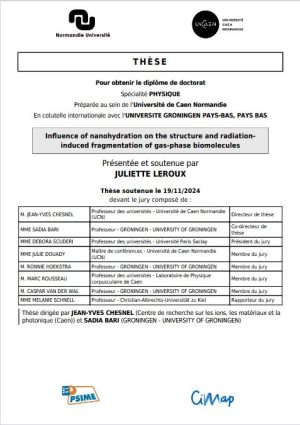Abstract:
In the biological medium, water conditions the structure and function of biomolecules, with the first solvation shell playing a fundamental role in these properties. To understand this particular role of water, a bottom-up approach can be utilized, such as investigating the stepwise hydration of biomolecules in the gas phase.
This thesis presents an experimental and theoretical study on the influence of nanohydration on the structure and physical processes of gas-phase biomolecules by irradiation with soft X-ray photons.
First, we described the experimental setup and the electrospray ionization source dedicated to producing nanohydrated biomolecules. In the second part, we studied the solvation of two model systems: deprotonated adenosine monophosphate (AMP) and protonated phosphorylated amino acid phosphotyrosine. Using quantum chemical calculations, we investigated the influence of stepwise solvation on the three-dimensional structure and spectroscopic characteristics of AMP. We demonstrated that a single water molecule already affects the geometry. Furthermore, we investigated the influence of a single water molecule on the structure and X-ray absorption spectra of phosphotyrosine. By combining soft X-ray spectroscopy with quantum chemical calculations, we could determine the location of the water molecule and demonstrate its features in the X-ray absorption spectrum at the oxygen K-edge. Lastly, we examined the electronic fingerprint of the protonation sites in model peptides using their X-ray spectra at the nitrogen K-edge. We mapped the differences in the electronic transitions caused by different proton locations at the nitrogen and oxygen sites present within the peptide backbone and amino acid side chains.
Keywords: Solvation, Biomolecules, Density-Functional theory, Soft X-Ray spectroscopy, Time-Of-Flight spectrometry, Photoabsorption, Electronic structure.
Influence de la nanohydratation sur la structure et la fragmentation radio-induite de biomolécules en phase gazeuse
Résumé :
Dans le milieu biologique, l’eau conditionne la structure et la fonction des biomolécules, la première couche de solvatation jouant un rôle fondamental dans ces propriétés. Pour comprendre ce rôle particulier de l’eau, une approche bottom-up peut être utilisée, comme l’étude de l’hydratation progressive des biomolécules en phase gazeuse.
Cette thèse présente une étude expérimentale et théorique de l’influence de la nanohydratation sur la structure et les processus physiques des biomolécules en phase gazeuse par irradiation avec des photons X.
Dans un premier temps, nous avons décrit le dispositif expérimental et la source d’ionisation par électrospray dédiée à la production de biomolécules nanohydratées. Dans la deuxième partie, nous avons étudié la solvatation de deux systèmes modèles : l’adénosine monophosphate déprotonée et la phosphotyrosine. À l’aide de calculs de chimie quantique, nous avons étudié l’influence de la solvatation progressive sur la structure tridimensionnelle et les caractéristiques spectroscopiques de l’AMP. Nous avons démontré qu’une seule molécule d’eau affecte déjà sa géométrie. En outre, nous avons étudié l’influence d’une seule molécule d’eau sur la structure et les spectres d’absorption des rayons X de la phosphotyrosine. En combinant la spectroscopie à rayons X avec des calculs de chimie quantique, nous avons pu déterminer l’emplacement de la molécule d’eau et démontrer ses caractéristiques dans le spectre d’absorption des rayons X à la couche K de l’oxygène. Enfin, nous avons examiné l’empreinte électronique des sites de protonation dans des peptides modèles à l’aide de leurs spectres de rayons X à la couche K de l’azote.
Mots-clés : Spectroscopie à rayons X mous.


